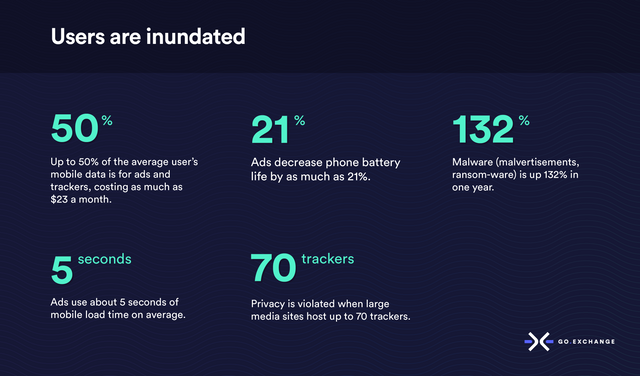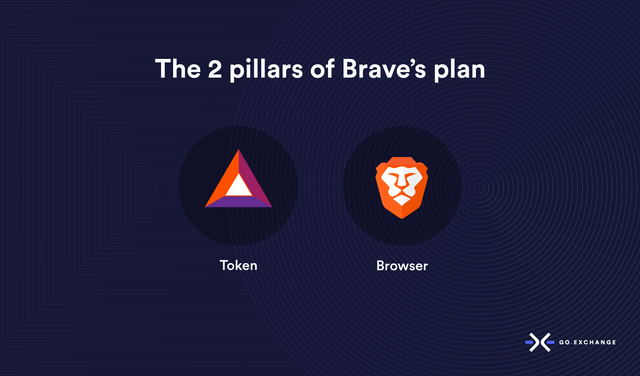Basic Attention Token: Denominating Attention

The Attention Age
The creation of information has scaled exponentially. There are 300 hours of video uploaded to YouTube every minute. Wordpress users publish nearly three million posts per day. More than 95 million photos are posted on Instagram each day. The Information Age brought about such an abundance of content that it vastly exceeds society’s ability to consume it. Our collective attention has remained relatively fixed, there are only so many hours, minutes, seconds in the day to do anything. This scarcity has influenced our habits and has changed how businesses approach getting and keeping attention.
Reed Hastings, the CEO of Netflix, has famously said “[Netflix’s] biggest competitors are YouTube, Facebook, and sleep.” These big technology companies are competing tooth and nail for every waking minute you spend on their platforms. As time goes on, and the exponential increase of the creation of content continues, this battle will only become more fierce.
The predominant business model in digital economies is monetizing attention through advertising. In the U.S., there exists a duopoly on this industry in Facebook and Google, controlling the lion’s share of advertising revenue. It’s not difficult to imagine that there are other practices with personal data these companies are incentivized to perform in the name of increasing advertising revenue. The danger in this centralization and total control on their part has been total, unchecked power in control over intimate personal data, with little regard to protection of privacy. The infamous Cambridge Analytica scandal brought attention to this in the public sphere. A simple Facebook quiz was able to harvest millions of user’s data without their explicit consent, and exported off the platform to be transferred freely. This marked a shift in sentiment surrounding user privacy protections from a legal perspective, and sparked an increase in awareness from consumers as to what exactly they were signing away.
There is tremendous opportunity for disruption in the attention economy. It will not be easy, as the power is so concentrated in a few entities. However, there is one player poised to take this concentration of power and return it to the user. That is Brave Software, Inc.
Brave’s grand vision is to take the entire advertising industry from the grasp of middlemen and platforms and decentralize it entirely. The benefits for users, publishers, and advertisers will be great.

Users are inundated
- Up to 50% of the average user’s mobile data is for ads and trackers, costing as much as $23 a month.
- Ads use about 5 seconds of mobile load time on average.
- Ads decrease phone battery life by as much as 21%.
- Privacy is violated when large media sites host up to 70 trackers.
- Malware (malvertisements, ransom-ware) is up 132% in one year.
Publishers are hurting
- Google and Facebook take 73% of all ad dollars and 99% of all growth.
- Revenue is recently down 66%.
- Bots inflicted $7.2 billion in fraud last year.
- Over 600 million phones and desktops run ad-blocking.
- Publishers cannot seamlessly monetize value added services.
Advertisers are losing
- Advertisers lack good information on what they are paying for.
- Marketers are often fooled by bogus websites and bots that commit fraud.
- Targeting is poor, making users more likely to ignore ads.
Source: https://basicattentiontoken.org/

To start
In typical startup fashion, Brave built a simple use case that immediately brings benefits to the users and publishers and acts as a growth engine. They built the Brave web browser to block ads and with a simple ledger system to allow users to award Basic Attention Tokens (BAT) to publishers. This simple feature lets any user of the web browser compensate a publisher. Direct compensation circumvents the traditional advertising model completely with the entirety going to the publisher. Instead of a users single view garnering a pittance of ad revenue, users speak with their wallets and reward publishers for the content they find valuable. A useful side effect of this feature is that users are the publishers aware of the platform and encouraging their enrollment in it. A simple incentive mechanism to garner attention in their disruption of the attention business model.
The Brave Browser contains an ad blocker built into the browser experience. For other browsers, the current process for users to achieve the same experience is placing trust in third party extensions. Native, in browser ad blocking allows for an ad free experience out of the box. Improvements can be seen immediately in page load speed times, battery life times, and data usage. This makes the very experience of using the Brave browser better than most competitors, a significant advantage for Brave that lays the groundwork for things to come.
Building the platform
The next step in this grand plan is the implementation of in-browser advertising. Because the advertising decision making occurs in browser, and not off an on ad platforms servers, all of the user data is kept on the local device. Brave never receives personal data, nor do advertisers, and nor do publishers.
Brave is slowly rolling out this feature to advertisers, and has started allowing users to opt-in to seeing ads. This fundamentally changes the users relationship with advertisements, as users asking to see ads in return for 70% of the ad revenue generated, with Brave keeping 30%. Users are getting paid to see ads and are no longer the product being served to advertisers. Users get paid to browse the web, without the risk of misuse of their personal data.
The end goal for this entire process to exist on the blockchain in a decentralized manner: currently advertisers purchase ad inventory through Brave directly, but their goal is to move to an entirely decentralized system to allow full transparency. A decentralized system, combined with an open source browser, will allow anyone to audit the entire process end to end. This would be an incredible advancement for such an innovative platform to be fully transparent, one that is closely coupled with the very ethos of decentralization. Brave is an excellent example of what can be accomplished when a great consumer focused product is paired with blockchain technology.
We’re really excited to list BAT on GO.Exchange. Brave is a breakthrough in the digital advertising industry and how attention can be valued, and one of the most consumer ready use cases in cryptocurrencies.
What are your thoughts on BAT? Join the conversation on Reddit, Telegram, or Twitter:
Disclaimer
This communication and any discussions in connection with this communication is solely for informational purposes and is subject to change at any time without notice. This communication should not be relied upon nor used as the basis for making any investment decision nor should this communication be construed as a recommendation to engage in any transaction or be construed as a recommendation of any investment strategy.
This communication is not related to the provision of advisory services regarding investment, tax, legal, financial, accounting, consulting or any other related services and are not recommendations to buy, sell, or hold any asset.
This communication is not a personal recommendation and does not take into account whether any transaction is allowable or suitable for a particular person or persons. The information contained in this communication is based on sources considered to be reliable, but not guaranteed, to be accurate or complete in any way. GO.Exchange is not responsible for information obtained or derived from third party sources or statistical services. Any opinions or estimates expressed herein reflect a judgment made as of this date, and are subject to change without notice.
Neither GO.Exchange nor any of its directors, officers, employees, representatives, affiliates or agents accepts any liability whatsoever for any direct indirect or consequential losses (in contract, tort or otherwise) arising from the use of this communication or its contents or reliance on the information contained herein.
In publishing this communication and any discussions in connection with this communication in physical, digital or other electronic form, GO.Exchange is neither advising on the value of or the advisability of trading in any sale of a commodity for future delivery, security futures product or swap, any retail commodity or retail foreign exchange agreement, contract or transaction, any commodity option or any leverage transaction nor soliciting funds, securities or property for the purpose of trading in any commodity.